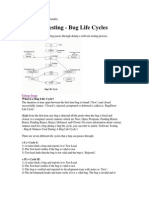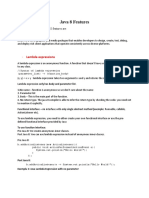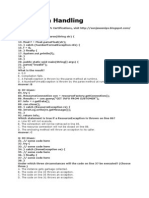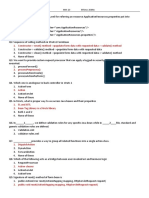JUNIT
Jan31,2015
�Test suites
2
Obviously you have to test your code to get it
working in the first place
You can do ad hoc testing (testing whatever occurs to you at
the moment), or
You can build a test suite (a thorough set of tests that can
be run at any time)
Disadvantages of writing a test suite
Its a lot of extra programming
You dont have time to do all that extra work
Truebut use of a good test framework can help quite a bit
FalseExperiments repeatedly show that test suites reduce
debugging time more than the amount spent building the test
suite
Advantages of having a test suite
Your program will have many fewer bugs
It will be a lot easier to maintain and modify your program
This is a huge win for programs that, unlike class assignments,
get actual use!
Example: Old way vs. new
way
int max(int a, int b) {
if (a > b) {
return a;
} else {
return b;
}
@Test
void testMax() {
assertEquals(7, max(3, 7));
assertEquals(3, max(3, -7));
}
}
void testMax() {
int x = max(3, 7);
if (x != 7) {
System.out.println("max(3, 7) gives " + x);
}
x = max(3, -7);
if (x != 3) {
System.out.println("max(3, -7) gives " + x);
}
}
public static void main(String[] args) {
new MyClass().testMax();
}
�XP approach to testing
4
In the Extreme Programming approach,
Tests are written before the code itself
If code has no automated test case, it is assumed not to work
A test framework is used so that automated testing can be
done after every small change to the code
This may be as often as every 5 or 10 minutes
If a bug is found after development, a test is created to keep
the bug from coming back
Consequences
Fewer bugs
More maintainable code
Continuous integrationDuring development, the program
always worksit may not do everything required, but what it
does, it does right
�JUnit
5
JUnit is a framework for writing tests
JUnit was written by Erich Gamma (of Design
Patterns fame) and Kent Beck (creator of XP
methodology)
JUnit uses Javas reflection capabilities (Java
programs can examine their own code)
JUnit helps the programmer:
define
and execute tests and test suites
formalize requirements and clarify architecture
write and debug code
integrate code and always be ready to release a
working version
JUnit is not included in Suns SDK, but almost all
IDEs include it
�Terminology
6
A test fixture sets up the data (both objects and
primitives) that are needed to run tests
Example: If you are testing code that updates an employee
record, you need an employee record to test it on
A unit test is a test of a single class
A test case tests the response of a single method to a
particular set of inputs
A test suite is a collection of test cases
A test runner is software that runs tests and reports
results
An integration test is a test of how well classes work
together
JUnit provides some limited support for integration tests
�Once more, in pictures
7
test suite
test runner
another unit test
test case (for one method)
another test case
another unit test
another test case
another test case
another test case
unit test (for one class)
test case (for one method)
another test case
test fixture
A unit test tests the
methods in a single class
A test case tests (insofar as
possible) a single method
You can have multiple test
cases for a single method
A test suite combines unit
tests
The test fixture provides
software support for all this
The test runner runs unit
tests or an entire test suite
Integration testing (testing
that it all works together) is
not well supported by JUnit
�Writing a JUnit test class, I
8
import org.junit.*;
import static org.junit.Assert.*; // note static import
Declare your test class in the usual way
public class MyProgramTest {
Start by importing these JUnit 4 classes:
Declare an instance of the class being tested
You can declare other variables, but dont
give them initial values here
public class MyProgramTest {
MyProgram program;
int someVariable;
�Writing a JUnit test class, II2
9
@Before
public void setUp() {
program = new MyProgram();
someVariable = 1000;
}
Define a method (or several methods) to be executed before
each test
Initialize your variables in this method, so that each test
starts with a fresh set of values
You can define one or more methods to be executed after
each test
Typically such methods release resources, such as files
Usually there is no need to bother with this method
@After
public void tearDown() {
}
�A simple example
10
Suppose you have a class Arithmetic with methods int multiply(int x, int y),
and boolean isPositive(int x)
import org.junit.*;
import static org.junit.Assert.*;
public class ArithmeticTest {
@Test
public void testMultiply() {
assertEquals(4, Arithmetic.multiply(2, 2));
assertEquals(-15, Arithmetic.multiply(3, -5));
}
@Test
public void testIsPositive() {
assertTrue(Arithmetic.isPositive(5));
assertFalse(Arithmetic.isPositive(-5));
assertFalse(Arithmetic.isPositive(0));
}
}
�Assert methods I
11
Within a test,
An assert method is a JUnit method that performs a test, and
throws an AssertionError if the test fails
JUnit catches these Errors and shows you the result
static void assertTrue(boolean test)
static void assertTrue(String message, boolean test)
Call the method being tested and get the actual result
Assert what the correct result should be with one of the assert
methods
These steps can be repeated as many times as necessary
Throws an AssertionErrorif the test fails
The optional message is included in the Error
static void assertFalse(boolean test)
static void assertFalse(String message, boolean test)
Throws an AssertionErrorif the test fails
�Example: Counter class
12
For the sake of example, we will create and test a
trivial counter class
We write the test methods before we write the code
The constructor will create a counter and set it to zero
The increment method will add one to the counter and return
the new value
The decrement method will subtract one from the counter
and return the new value
This has the advantages described earlier
However, we usually write the method stubs first, and let
the IDE generate the test method stubs
Dont be alarmed if, in this simple example, the
JUnit tests are more code than the class itself
�JUnit tests for Counter
13
public class CounterTest {
Counter counter1; // declare a Counter here
@Before
void setUp() {
counter1 = new Counter(); // initialize the Counter here
}
@Test
public void testIncrement() {
assertTrue(counter1.increment() == 1);
assertTrue(counter1.increment() == 2);
}
@Test
public void testDecrement() {
assertTrue(counter1.decrement() == -1);
}
Notethateachtest
beginswithabrand
newcounter
Thismeansyoudont
havetoworryabout
theorderinwhichthe
testsarerun
�The Counter class itself
14
public class Counter {
int count = 0;
public int increment() {
return count += 1;
}
public int decrement() {
return count -= 1;
}
public int getCount() {
return count;
}
Is JUnit testing overkill for
this little class?
The Extreme Programming
view is: If it isnt tested, it
doesnt work
You are not likely to have
many classes this trivial in a
real program, so writing
JUnit tests for those few
trivial classes is no big deal
Often even XP programmers
dont bother writing tests
for simple getter methods
such as getCount()
We only used assertTrue in
this example, but there are
additional assert methods
�Warning: equals
15
You can compare primitives with ==
Java has a method x.equals(y), for comparing objects
assertEquals(expected, actual) uses == or equals
To define equals for your own objects, define exactly
this method:
public boolean equals(Object obj) { ... }
This method works great for Strings and a few other Java classes
For objects of classes that you create, you have to define equals
The argument must be of type Object, which isnt what you
want, so you must cast it to the correct type (say, Person):
public boolean equals(Object something) {
Person p = (Person)something;
return this.name == p.name; // test whatever you like here
}
Well talk much more about equals later
�Assert methods II
16
assertEquals(expected, actual)
assertEquals(String message, expected, actual)
expected and actual must be both objects or the same
primitive type
For objects, uses your equals method, if you have defined it
properly, as described on the previous slide
assertSame(Objectexpected, Objectactual)
assertSame(String message, Objectexpected, Objectactual)
Asserts that two arguments refer to the same object
assertNotSame(Objectexpected, Objectactual)
assertNotSame(String message, Objectexpected, Objectactual)
Asserts that two objects do not refer to the same object
�Assert methods III
17
assertNull(Objectobject)
assertNull(String message, Objectobject)
Asserts that the object is null (undefined)
assertNotNull(Objectobject)
assertNotNull(String message, Objectobject)
Asserts that the object is null
fail()
fail(String message)
Causes the test to fail and throw an AssertionFailedError
Useful as a result of a complex test, when the other
assert methods arent quite what you want
�Writing a JUnit test class, III
18
This page is really only for expensive setup, such as
when you need to connect to a database to do your
testing
@BeforeClass
public static void setUpClass() throws Exception {
// one-time initialization code
}
If you wish, you can declare one method to be executed just once,
when the class is first loaded
If you wish, you can declare one method to be executed just once,
to do cleanup after all the tests have been completed
@AfterClass
public static void tearDownClass() throws Exception {
// one-time cleanup code
}
�Special features of @Test
19
@Test (timeout=10)
public void greatBig() {
assertTrue(program.ackerman(5, 5) > 10e12);
}
You can limit how long a method is allowed to take
This is good protection against infinite loops
The time limit is specified in milliseconds
The test fails if the method takes too long
Some method calls should throw an exception
You can specify that a particular exception is expected
The test will pass if the expected exception is thrown, and fail
otherwise
@Test (expected=IllegalArgumentException.class)
public void factorial() {
program.factorial(-5);
}
�20
Test-Driven Development
(TDD)
It is difficult to add JUnit tests to an existing program
The program probably wasnt written with testing in mind
Its actually better to write the tests before writing
the code you want to test
This seems backward, but it really does work better:
When tests are written first, you have a clearer idea what to
do when you write the methods
Because the tests are written first, the methods are
necessarily written to be testable
Writing tests first encourages you to write simpler, singlepurpose methods
Because the methods will be called from more than one
environment (the real one, plus your test class), they tend
to be more independent of the environment
�Stubs
21
In order to run our tests, the methods we are testing
have to exist, but they dont have to be right
Instead of starting with real code, we start with stubs
minimal methods that always return the same values
A stub that returns void can be written with an empty body
A stub that returns a number can return 0 or -1 or 666, or
whatever number is most likely to be wrong
A stub that returns a boolean value should usually return false
A stub that returns an object of any kind (including a String or
an array) should return null
When we run our test methods with these stubs, we
want the test methods to fail!
This helps test the teststo help make sure that an incorrect
method doesnt pass the tests
�Ignoring a test
22
The @Ignore annotation says to not run a test
@Ignore("I dont want Dave to know this doesnt work")
@Test
public void add() {
assertEquals(4, program.sum(2, 2));
}
You shouldnt use @Ignore without a very good reason!
�Test suites
23
You can define a suite of tests
@RunWith(value=Suite.class)
@SuiteClasses(value={
MyProgramTest.class,
AnotherTest.class,
YetAnotherTest.class
})
public class AllTests { }
�JUnit in Eclipse
24
If you write your method stubs first (as on the previous slide),
Eclipse will generate test method stubs for you
To add JUnit 4 to your project:
Select a class in Eclipse
Go to File New... JUnit Test Case
Make sure New JUnit 4 test is selected
Click where it says Click here to add JUnit 4...
Close the window that appears
To create a JUnit test class:
Do steps 1 and 2 above, if you havent already
Click Next>
Use the checkboxes to decide which methods you want test cases
for;
dont select Object or anything under it
I like to check create tasks, but thats up to you
Click Finish
To run the tests:
Choose Run Run As JUnit Test
�Viewing results in Eclipse
25
Bar is green if
all tests pass,
red otherwise
This test passed
Something is wrong
Depending on your
preferences, this
window might show
only failed tests
Ran 10 of
the 10 tests
No tests
failed, but...
Something unexpected
happened in two tests
This is how
long the
test took
�Recommended approach
26
Write a test for some method you intend to write
Write a stub for the method
Run the test and make sure it fails
Replace the stub with code
Write just enough code to pass the tests
Run the test
If the method is fairly complex, test only the simplest case
If it fails, debug the method (or maybe debug the test);
repeat until the test passes
If the method needs to do more, or handle more
complex situations, add the tests for these first,
and go back to step 3
�The End
27
Ifyoudontunittestthenyouarentasoftwareengineer,youarea
typistwhounderstandsaprogramminglanguage.
MosesJones
1.Neverunderestimatethepowerofonelittletest.
2.Thereisnosuchthingasadumbtest.
3.Yourtestscanoftenfindproblemswhereyourenotexpecting
them.
4.Testthateverythingyousayhappensactuallydoeshappen.
5.Ifitsworthdocumenting,itsworthtesting.
AndyLester



































































































